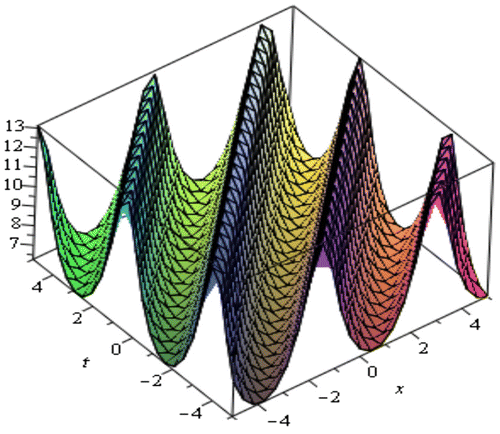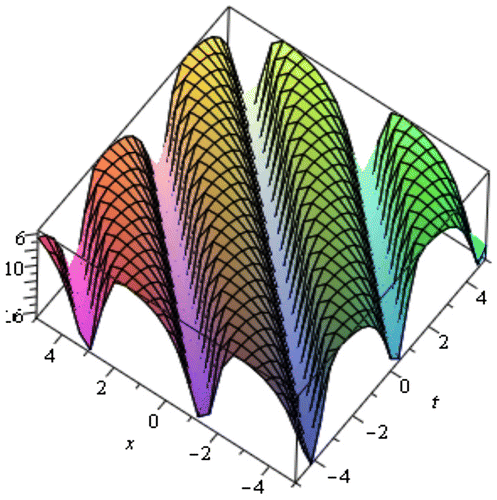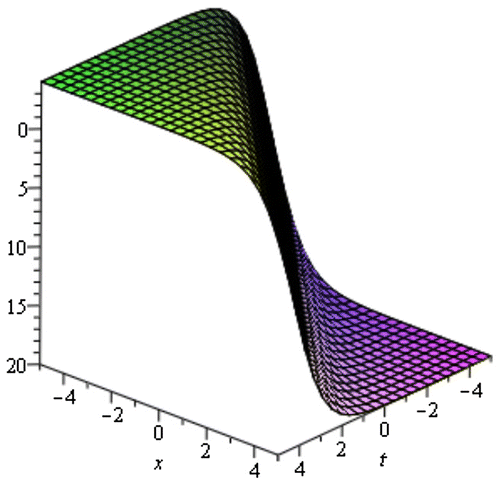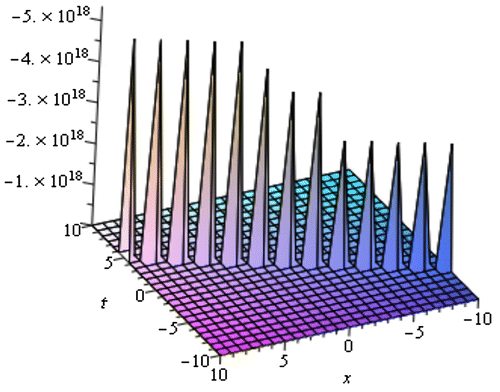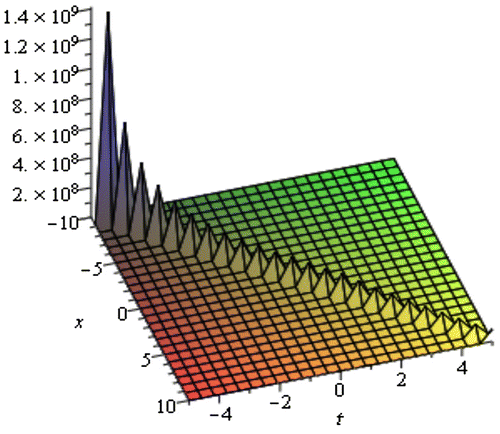 ?Mathematical formulae have been encoded as MathML and are displayed in this HTML version using MathJax in order to improve their display. Uncheck the box to turn MathJax off. This feature requires Javascript. Click on a formula to zoom.
?Mathematical formulae have been encoded as MathML and are displayed in this HTML version using MathJax in order to improve their display. Uncheck the box to turn MathJax off. This feature requires Javascript. Click on a formula to zoom.Abstract
The exploration of closed form wave solutions of nonlinear evolution equations (NLEEs) is an important research area in the field of physical sciences and engineering. In this article, we investigate closed form wave solution of two nonlinear equations, namely, the time regularized long wave equation and the (2 + 1)-dimensional nonlinear Schrodinger equation by the modified simple equation method. These equations play significant role in nonlinear sciences. The solutions are obtained in explicit form of the variables in the considered equations. The derived solutions are revealed in the form of exponential and trigonometric functions including solitary and periodic solutions. It is shown that the method is effective and an essential mathematical tool for constructing the closed form wave solutions of NLEEs in mathematical physics.
Public Interest Statement
Nonlinear evolution equations (NLEEs) frequently arise in formulating fundamental laws of nature and a wide variety of problems naturally arising from solid-state physics, plasma physics, ocean and atmospheric waves, meteorology etc. Closed form solutions to NLEEs play a significant role in nonlinear science, especially in nonlinear physical science, since it can provide much physical information and more insight into the physical aspects of the problem. Therefore, numerous techniques have been developed by several groups of mathematicians and physicists to examine closed form solutions to NLEEs. In this article, we use the modified simple equation method to extract fresh and further general exact traveling wave solutions to the time regularized long wave equation and nonlinear telegraph equation. Thus, we obtain closed form wave solutions of these two equations among them some are new solutions. We expect that the new exact traveling wave solutions will be helpful to illuminate the connected phenomena.
1. Introduction
It is noteworthy to observe that the nonlinear evolution equations (NLEEs) are broadly used to formulate mathematical model of nonlinear wave phenomena appearing in the field of science and engineering. Therefore, the studies of the NLEEs have become a significant area of research in the recent years. In order to better understand the inner infrastructure of the phenomena described by the NLEEs, closed form solitary wave solutions play an imperative role. The closed form solutions of these equations give information about the structure of these problems and allow the researchers to design and experiments by creating appropriate conditions to determine these parameters or functions. Thus, we are motivated to search the closed form wave solutions of two important nonlinear wave equations, as for instance the time regularized long wave (TRLW) equation and the (2 + 1)-dimensional nonlinear Schrodinger equation (NLSE). The TRLW equation arises in the study of shallow water waves and the (2 + 1)-dimensional NLSE is the modeling equation of optics, heat conduction in solids. A soliton is special sort of solitary wave that retains it shape, velocity, and amplitude after colliding with another solitary wave. Soliton phenomena are observed in optical fibers, plasma physics, nuclear physics, biophysics, high-energy physics, meteorology, biology, solid-state physics, elastic media, chemical kinematics, geochemistry etc. As a result, the closed form solitary wave solutions of NLEEs have been investigated by many researchers who are interested in nonlinear phenomena. Recently significant improvements have been made for searching closed form solitary wave solutions of NLEEs and several effective and useful methods have been established and extended, such as the nonlinear transform method (Yang, Liu, & Yang, Citation2001), the first integration method (Taghizadeh & Mirzazadeh, Citation2011), the homogeneous balance method (Wang, Citation1995; Zayed, Zedan, & Gepreel, Citation2004), the simplified Hirota’s method (Wazwaz, Citation2014), the functional variable method (Çevikel, Bekir, Akar, & San, Citation2012), the Jacobi-elliptic function expansion method (Liu, Fu, Liu, & Zhao, Citation2001), Hirota’s bilinear transformation method (Hirota, Citation1973; Hirota & Satsuma, Citation1981), the tanh-function method (Nassar, Abdel-Razek, & Seddeek, Citation2011), the complex hyperbolic function method (Wang & Zhou, Citation2003), the Adomian decomposition method (Adomian, Citation1994), the Exp-function method (Akbar & Ali, Citation2011; Ebadi, Krishnan, Labidi, Zerrad, & Biswas, Citation2011), the modified Exp-function method (He, Li, & Long, Citation2012), the Painleve expansion method (Weiss, Tabor, & Carnevale, Citation1982), the variational iteration method (Helal & Seadawy, Citation2009; Seadawy, Citation2011), the Riccati equation method (Dai, Wang, & Biswas, Citation2014), the -expansion method (Islam, Alam, Sazzad Hossain, Roshid, & Akbar, Citation2013; Islam, Khan, & Akbar, Citation2015; Khan & Akbar, Citation2013), the perturbation method (Antonova & Biswas, Citation2009; Girgis & Biswas, Citation2010), the extended Jacobi elliptic function method (Bhrawy, Abdelkawy, & Biswas, Citation2014), the Lie group symmetry method (Biswas & Kara, Citation2011), the (G′/G)-expansion method (Akbar, Ali, & Zayed, Citation2012; Alam, Akbar, & Roshid, Citation2013; Taghizadeh & Foumani, Citation2016), the enhanced (G′/G)-expansion method (Hossain & Akbar, Citation2017), the improve (G′/G)-expansion method (Zhang, Jiang, & Zhao, Citation2010), the generalized Kudryashov method (Zayed & Al-Nowehy, Citation2016), the modified simple equation method (Akter & Akbar, Citation2015; CitationHossain & Akbar, 2017; Hossain, Akbar, & Wazwaz, Citation2017; Jawad, Petkovic, & Biswas, Citation2010; Khan & Akbar, Citation2013; Taghizadeh, Mirzazadeh, Paghaleh, & Vahidi, Citation2012), the sine-cosine function method (Jawad, Kumar, & Biswas, Citation2014), the extended direct algebraic method (Seadawy, Citation2014, Citation2015, Citation2016, Citation2017; Seadawy & El-Rashidy, Citation2013), the modified extended direct algebraic method (Seadawy, Citation2015, Citation2016), the modified extended auxiliary equation method (Seadawy, Arshad, & Lu, Citation2017), the solitary ansatz method (Biswas, Citation2008, Citation2009, Citation2010; Biswas & Milovic, Citation2008, Citation2009; Krishnan, Triki, Labidi, & Biswas, Citation2011; Sturdevant, Lott, & Biswas, Citation2009; Triki, Lepule, Love, Kara, & Biswas, Citation2014; Triki, Mirzazadeh, Bhrawy, Razborova, & Biswas, Citation2015; Xu et al., Citation2013), the symmetry reduction method (Abdel-Rahman, Citation2008) and others (Biswas, Citation2009; Khalique, Majid, & Biswas, Citation2011; Triki, Sturdevant, Hayat, Aldossary, & Biswas, Citation2011).
The modified simple equation (MSE) method is a recently developed straightforward, effective and rising method and getting popular day by day. The objective of this article is to execute the MSE method to construct the closed form soliton solutions to the TRLW equation and the (2 + 1)-dimensional NLSE. The rest of the article is prepared as follows: In Section 2, MSE method is delineated. In Section 3, the method is implemented to examine the NLEEs indicated above. In Section 4, results and physical explanations are discussed and in Section 5 conclusions are provided.
2. The modified simple equation MSE Method
In order to describe the MSE method, let us consider a nonlinear evolution equation in two independent variables x and t in the form:(2.1)
(2.1)
where u = u(x, t) is an unknown function and is a polynomial of u(x, t) and its partial derivatives wherein the highest order derivatives and nonlinear terms are involved and the subscripts are used for partial derivatives. The important steps of this method are presented in the following:
Step 1: Initiating a compound variable , we combine the real variables x and t:
(2.2)
(2.2)
where c is the speed of the solitary wave.
The wave transformations (2.2) allow us in reducing Equation (2.1) into an ODE for in the form:
(2.3)
(2.3)
where is a polynomial in
and its derivatives, the prime stands for the derivative with respect to ξ.
Step 2: Assume the solution of (2.3) can be revealed of the form:
(2.4)
(2.4)
where are arbitrary constants to be determined such that aN ≠ 0 and ψ(ξ) is an unknown function to be evaluated later, such that
. The characteristic and uniqueness of this method is that, ψ(ξ) is not known function or not a solution of any predefined differential or algebraic equation, whereas in the sine-cosine method, Exp-function method, tanh-function method, (G′/G)-expansion method, Jacobi elliptic function method etc., the solution are introduced in the form of known function. Therefore, it is not possible to speculate in advance what kind of solutions one may obtain through this method. Thus, it might be possible to achieve some fresh solution by this method.
Step 3: We determine the positive integer N arises in (2.4) by balancing the highest order of linear and nonlinear terms appearing in (2.3).
Step 4: Compute the necessary derivatives and insert Equation (2.4) into (2.3) and then we account the function
. The above procedure yields a polynomial in (1/ψ(ξ)). Equating the coefficients of same power of this polynomial to zero, yields a system of algebraic and differential equations that can be solved to get
, ψ(ξ) and the value of other needful parameters. This completes the determination of solutions to the Equation (2.1).
3. Formulations of the solutions
In this section, MSE method has been put to use to examine the closed form solutions directed to solitary wave solutions to the TRLW equation and the (2 + 1)-dimensional NLSE.
3.1. The TRLW equation
In this sub-section, the MSE method has been implemented to examine the closed form solutions to the TRLW equation , which is one of the alternative forms of the KdV equation (Islam et al., Citation2015):
(3.1)
(3.1)
where u, t and x denote the amplitude, time, and spatial coordinate, respectively, and α is a nonzero constant. The first term is the evolution term, and the third term is the nonlinear term, while the fourth term is the dispersion term. The third term uux accounts for steepening of the wave and the dispersion term represented by uxtt spreading the wave. Nonlinearity tends to localize the wave while dispersion spreads it out. The solitons are the result of a intricate balance between dispersion and nonlinearity.
The traveling wave transformations
where c is the wave speed, converts the Equation (3.1) into an ODE of the form
(3.2)
(3.2)
Integrating (3.2) with respect to ξ once and the setting the constant of integration to zero, reduces to
(3.3)
(3.3)
Balancing u2 and u″, yields N = 2.
Therefore, the solution of Equation (3.3) turns out to be
(3.4)
(3.4)
where a0, a1 and a2 are constants, such that a2 ≠ 0 and ψ(ξ) is an unknown function to be calculated. Substituting (3.4) and its derivatives into (3.3) and then equating the coefficients of ψ0, ψ−1, ψ−2, ψ−3, ψ−4 to zero we achieve the successive algebraic and differential equations
(3.5)
(3.5)
(3.6)
(3.6)
(3.7)
(3.7)
(3.8)
(3.8)
(3.9)
(3.9)
From Equation (3.5), we obtain
Also from Equation (3.9), we achieve since a2 ≠ 0.
From Equation (3.8), it can be deduced that
(3.10)
(3.10)
where
Integrating (3.10) with respect to ξ, yields
(3.11)
(3.11)
And
(3.12)
(3.12)
where c1 and c2 are integral constants.
Case 1: When and
, solving Equations (3.6) and (3.7) by using (3.11)–(3.12), we attain
and c = c. Inserting the values of a0, a1 and a2 in (3.4), it is derived
(3.13)
(3.13)
where and
.
Simplifying the exponential function solution (3.13), it transformed to the hyperbolic function as,
(3.14)
(3.14)
Since c1 and are arbitrary constants, one might randomly choose their values, Therefore, if we choose c1 = 1 and
, from Equation (3.15), we obtain the following closed form soliton solution.
In (x, t) variables the above closed form wave solution can be written as follows:
(3.15)
(3.15)
Again if we choose c1 = 1 and , the closed form solution (3.14) turns into
Therefore, the closed form wave solution of the TRLW equation in (x, t) variables as follows:
(3.16)
(3.16)
Case 2: When and
, solving Equation (3.6) and (3.7), we get
and c = c. Then by setting the values of a0, a1 and a2 in (3.4), we obtain
(3.17)
(3.17)
where and
Converting the solution into hyperbolic function by using the exponential function identity, the close form solution (3.17) becomes
(3.18)
(3.18)
Since c1 and c2 integral constants, setting c1 = 1 and into (3.18), provides
The above closed form soliton solution of the TRLW equation in (x, t) variables becomes:(3.19)
(3.19)
Again if we set c1 = 1 and , the solution (3.18) becomes
Thus, in (x, t) variables, the closed form traveling wave solution of the TRLW equation becomes:
(3.20)
(3.20)
3.2. The nonlinear Schrodinger equation
In this sub-section, we derive the closed form solitary wave solutions of the (2 + 1)-dimensional NLSE (Jawad et al., Citation2014) by means of the method described in Section 2:
(3.21)
(3.21)
where q = q(x, y, t) is a complex valued function, and
and c are non-zero real parameters wherein a and b dissipation coefficients and c self-phase modulation. The first term represents the evolution term, the second and third terms represent the dissipation while the fourth term represents nonlinearity. The balance between these linear term and nonlinear term formulate the solitons. The mathematical model of the nonlinear Schrodinger Equation (3.21) arises as an approximate model of the evolution of a nearly monochromatic wave of small amplitude in pulse propagation along optical fibers and in gravity waves in deep water (Abdel-Rahman, Citation2008).
The complex transformations where
,
are real constants and
is velocity of the solitary wave, reduce the Equation (3.21) into an ordinary differential equation of the form:
(3.22)
(3.22)
From the above Equation (3.22), we obtain ω = 2(aα + bβ) and satisfy the ODE
(3.23)
(3.23)
Equation (3.23) can be written as
(3.24)
(3.24)
where and
.
Taking homogeneous balance between the highest-order derivative term u″ and the highest-order nonlinear term u3 yields n = 1.
Therefore, the solution of Equation (3.24) reduces to the form,
(3.25)
(3.25)
where a0 and a1 are constants, such that a1 ≠ 0 and ψ(ξ) is an unknown function to be calculated. Substituting (3.25) and its derivatives into (3.24) and completing the similar procedure as described in subsection 3.1, we attain the following successive algebraic and differential equations,
(3.26)
(3.26)
(3.27)
(3.27)
(3.28)
(3.28)
(3.29)
(3.29)
From Equations (3.26) and (3.29), we obtain and
since
.
(3.30)
(3.30)
where Integrating (3.30) with respect to ξ, yields
(3.31)
(3.31)
And
(3.32)
(3.32)
where c1 and are constants of integration.
Case 1: When ,
, and ω = 2(aα − bβ), substitute these values into (3.25), it is found that
(3.33)
(3.33)
where ξ = k(x + y - 2(aα − bβ)t) and .
Since c1 and c2 are constants of integration, one might randomly pick their values. Therefore, if we pick c1 = 1 and c2 = 1/θ from Equation (3.33), we attain exponential form wave solution and simplifying this exponential solution, we derive the following closed form solitary solution of the nonlinear Schrodinger equation:
(3.34)
(3.34)
On the other hand, if we pick c1 = −1 and c2 = 1/θ, from Equation (3.33), we attain the following closed form solution of the nonlinear Schrodinger equation:
(3.35)
(3.35)
Thus, in variables, the general closed form traveling wave solution of the nonlinear Schrodinger equation is obtained as follows:
(3.36)
(3.36)
(3.37)
(3.37)
Using hyperbolic functions identities, Equations (3.34) and (3.35) can be rewritten as
(3.38)
(3.38)
(3.39)
(3.39)
Case 2: When a0 = 0 and, and ω = 2(aα - bβ) then substitute these values of a0, a1and ω in (3.25) does not satisfy one of the algebraic Equation (3.28) hence the solution must be rejected.
4. Discussion and physical explanations
In this section, we have discussed about the obtained solution of the TRLW equation and the (2 + 1)-dimensional NLSE. Using the MSE method, we achieved the solitary wave solutions from (3.13) to (3.20) of the TRLW equation. These solutions are generally closed form traveling wave solutions which includes periodic wave solution, soliton solution, kink shape wave solution, bell shape soliton solution, and singular solution. When the center position of the solitary wave is imaginary then singular solitons can be connected to solitary waves. Since this type of solution has the nature of spike and therefore it can probably provide an explanation to the formation of Rogue waves. Kink type soliton solutions are important to transfer signal and information in optical fiber. Periodic traveling waves also play an important role in various physical phenomena, including reaction-diffusion-advection systems, impulsive systems, self-reinforcing systems, etc. Mathematical modeling of many intricate physical events, for instance physics, mathematical physics, computer science and many more phenomena resemble periodic traveling wave solutions. From the above solution, it has been detected that the solutions (3.13) and (3.14) provides periodic wave solution where the solutions (3.15) and (3.16) gives soliton solution. The solutions (3.18)–(3.19) and the solution (3.20) shows the nature of bell shape soliton and singular soliton, respectively, where (3.17) represents kink shape solution. The periodic wave solution (3.13) and (3.14) is represented by the Figures and for within the interval
. The solution (3.17) shows the shape of kink type solution in Figure for
within the interval
.The bell shape soliton solution (3.19) for
within the interval
is corresponding to the Figure . The singular soliton solution (3.20) for
within the interval −10 ≤ x, t ≤ 10 is represented by Figure . From the solutions of the (2 + 1)-dimensional nonlinear Schrodinger equation, it is observed that the solutions (3.34)–(3.39) are singular periodic solutions where the solution (3.33) represents periodic wave solution. The solution (3.33) is represented in Figure . It shows the periodic solution with
within the interval −3 ≤ t ≤ 3. The singular periodic solution (3.39) for
within the interval −10 ≤ x ≤ 10 and −5 ≤ t ≤ 5 is given by Figure . The figures of others solutions are similar to singular periodic solution type and ignored these figures for simplicity.
5. Conclusion
In this article, the modified simple equation method has been successfully implemented to establish the closed form solitary wave solutions of the TRLW equation and the (2 + 1)-dimensional NLSE. The solutions are verified to check the correctness by inserting them back into the original equation and found correct.Here, we achieved the value of the coefficients a0, a1 etc. without using any symbolic computation software such as Maple, Mathematica, etc. The used method is much simpler in comparing to other methods because this method is straightforward and its calculation procedure is very concise. Therefore, the applied method is quite efficient and practically well suited and could be more effectively used to solve various NLEEs which regularly arise in science, engineering and other technical arenas.
Funding
The authors received no direct funding for this research.
Acknowledgement
The authors wish to take this chance to express their gratitude to the anonymous referees for their valuable comments and suggestions to improve the quality of this article.
Additional information
Notes on contributors
A.K.M. Kazi Sazzad Hossain
Mr A.K.M. Kazi Sazzad Hossain is an assistant professor at the Department of Mathematics, Begum Rokeya University, Rangpur, Bangladesh. Earlier in 2012, he joined at the same Department as a lecturer. He obtained his BSc (Honors) from Mathematics and MSc from Applied Mathematics, Rajshahi University, Bangladesh. At present he is undertaking PhD at the Department of Applied Mathematics, Rajshahi University, Bangladesh. He has published four research article and submitted another five.
M. Ali Akbar
M. Ali Akbar is an associate professor at the Department of Applied Mathematics, Rajshahi University, Bangladesh. He received his PhD in Mathematics from the Department of Mathematics, Rajshahi University, Bangladesh. He is actively involved in research in the field of nonlinear differential equations and fractional calculus. He has published more than 150 research articles of which 60 articles are published in ISI (Thomson Reuter) indexed journals and other 15 articles published in Scopus indexed journals.
Md. Abul Kalam Azad
Md. Abul kalam Azad is a professor at the Department of Applied Mathematics, Rajshahi University, Bangladesh. He has published more than 50 articles in the international journals.
References
- Abdel-Rahman, R. G. (2008). New exact solutions of the (2+1)-dimensional nonlinear Schrodinger equation. Chinese Journal of Physics, 46(5), 495–510.
- Adomian, G. (1994). Solving frontier problems of physics: The decomposition method. Boston, MA: Kluwer Academic, Periodic.10.1007/978-94-015-8289-6
- Akbar, M. A., & Ali, N. H. M. (2011). Exp-function method for Duffing equation and new solutions of (2+1) dimensional dispersive long wave equations. Program in Applied Mathematics, 1(2), 30–42.
- Akbar, M. A., Ali, N. H. M., & Zayed, E. M. E. (2012). Abundant exact traveling wave solutions of the generalized Bretherton equation via (G′/G)-expansion method. Communications in Theoretical Physics, 57, 173–178.10.1088/0253-6102/57/2/01
- Akter, J., & Akbar, M. A. (2015). Exact solutions to the Benney-Luke equation and the Phi-4 equations by using modified simple equation method. Results in Physics, 5, 125–130.10.1016/j.rinp.2015.01.008
- Alam, M. N., Akbar, M. A., & Roshid, H. O. (2013). Study of nonlinear evolution equations to construct traveling wave solutions via the new approach of generalized (G′/G) -expansion method. Mathematics and Statistics, 1(3), 102–112. doi:10.13189/ms.2013.010302
- Antonova, Mariana, & Biswas, Anjan (2009). Adiabatic parameter dynamics of perturbed solitary waves. Communications in Nonlinear Science and Numerical Simulation, 14(3), 734–748.10.1016/j.cnsns.2007.12.004
- Bhrawy, A. H., Abdelkawy, M. A., & Biswas, A. (2014). Optical solitons in (1+1) and (2+1) dimensions. Optik - International Journal for Light and Electron Optics, 125(4), 1537–1549.10.1016/j.ijleo.2013.08.036
- Biswas, A. (2008). 1-soliton solution of 1+2 dimensional nonlinear schrodinger’s equation in dual-power law media. Physics Letters A, 372(38), 5941–5943.10.1016/j.physleta.2008.07.052
- Biswas, A. (2009a). 1-soliton solution of 1+2 dimensional nonlinear schrodinger’s equation in power law media, Comm. Communications in Nonlinear Science and Numerical Simulation, 14(5), 1830–1833.10.1016/j.cnsns.2008.08.003
- Biswas, A. (2009b). Topological 1-soliton solution of the nonlinear schrodinger’s equation with kerr law nonlinearity in 1+2 dimensions, Comm. Communications in Nonlinear Science and Numerical Simulation, 14(7), 2845–2847.10.1016/j.cnsns.2008.09.025
- Biswas, A. (2009c). 1-soliton solution of 1+2 dimensional nonlinear schrodinger’s equation in parabolic law media. Nonlinear Studies, 16(1), 49–55.
- Biswas, A. (2010). Solitary waves for power-law regularized long-wave equation and R(m,n) equation. Nonlinear Dynamics, 59(3), 423–426.10.1007/s11071-009-9548-2
- Biswas, A., & Kara, A. H. (2011). Conservation laws for regularized long-wave equations and R(m; n) equations. Advanced Science Letters, 4(1), 168–170.10.1166/asl.2011.1159
- Biswas, A., & Milovic, D. (2008). Optical solitons in 1 + 2 dimensions with time-dependent dispersion, nonlinearity and attenuation in a Kerr-Law media. Journal of Electromagnetic Waves and Applications, 22(13), 1801–1808.10.1163/156939308786375154
- A. Biswas, & D. Milovic. (2009). Optical solitons in 1+2 dimensions with non-kerr law nonlinearity, The European Physical Journal Special Topics, 173(1), 81–86.
- Çevikel, A. C., Bekir, A., Akar, M., & San, S. (2012). A procedure to construct exact solution of nonlinear evolution equations. Pramana – Journal of Physics, 79(3), 337–344.10.1007/s12043-012-0326-1
- Dai, C. Q., Wang, Y. Y., & Biswas, A. (2014). Dynamics of dispersive long waves in fluids. Ocean Engineering, 81, 77–88.10.1016/j.oceaneng.2014.02.007
- Ebadi, G., Krishnan, E. V., Labidi, M., Zerrad, E., & Biswas, A. (2011). Analytical and numerical solutions for davey-stewartson equation with power law nonlinearity. Waves in Random and Complex Media, 21(4), 559–590.10.1080/17455030.2011.606853
- Girgis, L., & Biswas, A. (2010). Soliton perturbation theory for nonlinear wave equations. Applied Mathematics and Computation, 216(7), 2226–2231.10.1016/j.amc.2010.03.056
- He, Y., Li, S., & Long, Y. (2012). Exact solutions of the Klein-Gordon equation by modified Exp-function method. International Mathematical Forum, 7(4), 175–182.
- Helal, M. A., & Seadawy, A. R. (2009). Variational method for the derivative nonlinear Schrodinger equation with computational applications. Physica Scripta, 80, 350–360.
- Hirota, R. (1973). Exact envelope soliton solutions of a nonlinear wave equation, Journal of Mathematical Physics, 14, 805–809.10.1063/1.1666399
- Hirota, R., & Satsuma, J. (1981). Soliton solutions of a coupled KDV equation. Physics Letters A, 85, 404–408.
- Hossain, A. K. M. K. S., & Akbar, M. A. (2017). Closed form solutions of two nonlinear equations via enhanced (G′/G)-expansion method, Cogent Mathematics, 4(1), 1312751. doi:10.1080/23311835.2017.1355958
- Hossain, A. K. M. K. S., & Akbar, M. A.. (2017). Traveling wave solutions of nonlinear evolution equations via Modified simple equation method, Journal of Applied Mathematics and Theoretical Physics, 3(2), 20–25. doi:10.11648/j.ijamtp.20170302.11
- Hossain, A. K. M. K. S., Akbar, M. A., & Wazwaz, A. M.. (2017). Closed form solutions of complex wave equations via modified simple equation method, Cogent Physics, 4, 1312751. doi: 10.1080/23311940.2017.1312751
- Islam, R., Alam, M. N., Sazzad Hossain, A. K. M. K., Roshid, H. O., & Akbar, M. A. (2013). Traveling wave solutions of nonlinear evolution equations via Exp(−Φ(η))-expansion method. Global Journal of Science Frontier Research, 13(11), 63–71.
- Islam, S. M. R., Khan, K., & Akbar, M. A. (2015). Exact solutions of unsteady Korteweg-de Vries and time regularized long wave equations. Springer Plus, 4, 988. doi:10.1186/s40064-015-0893-y
- Jawad, A. J. M., Petkovic, M. D., & Biswas, A. (2010). Modified simple equation method for nonlinear evolution equations. Applied Mathematics and Computation, 217, 869–877.10.1016/j.amc.2010.06.030
- Jawad, A. J. M., Kumar, S., & Biswas, A. (2014). Solition solutions of a few nonlinear wave equations in engineering sciences. Scientia Iranica D, 21(3), 861–869.
- Khalique, C. M., Majid, F., & Biswas, A.. (2011). Stationary optical solitons with kerr and power law nonlinearity in 1+2 dimensions, Advanced Science Letters, 4(11), 3676–3677.10.1166/asl.2011.1874
- Khan, K., & Akbar, M. A. (2013). Application of exp(-Φ(η))-expansion method to find the exact solutions of modified Benjamin-Bona-Mahony equation. World Applied Sciences Journal, 24(10), 1373–1377.
- Khan, K., & Akbar, M. A. (2013). Exact and solitary wave solutions for the Tzitzeica-Dodd-Bullough and the modified KdV-Zakharov-Kuznetsov equations using the modified simple equation method. Ain Shams Engineering Journal, 4(4), 903–909.10.1016/j.asej.2013.01.010
- Krishnan, E. V., Triki, H., Labidi, M., & Biswas, A. (2011). A study of shallow water waves with Gardner’s equation. Nonlinear Dynamics, 66(4), 497–507.10.1007/s11071-010-9928-7
- Liu, S., Fu, Z., Liu, S. D., & Zhao, Q. (2001). Jacobi elliptic function expansion method and periodic wave solutions of nonlinear wave equations. Physics Letters A, 289, 69–74.10.1016/S0375-9601(01)00580-1
- Nassar, H. A., Abdel-Razek, M. A., & Seddeek, A. K. (2011). Expanding the tan h-function method for solving nonlinear equations. Applied Mathematics, 2, 1096–1104.
- Seadawy, A. R. (2011). New exact solutions for the KdV equation with higher order nonlinearity by using the variational method. Computers & Mathematics with Applications, 62, 3741–3755.10.1016/j.camwa.2011.09.023
- Seadawy, A. R. (2014). Stability analysis for Zakharov-Kuznetsov equation of weakly nonlinear ion-acoustic waves in a plasma. Computers & Mathematics with Applications, 67, 172–180.10.1016/j.camwa.2013.11.001
- Seadawy, A. R. (2015). Approximation solutions of derivative nonlinear Schrödinger equation with computational applications by variational method. The European Physical Journal – Plus, 130(182), 1–10.
- Seadawy, A. R. (2015). Fractional solitary wave solutions of the nonlinear higher-order extended KdV equation in a stratified shear flow: Part I. Computers & Mathematics with Applications, 70, 345–352.10.1016/j.camwa.2015.04.015
- Seadawy, A. R. (2016). Three-dimensional nonlinear modified Zakharov-Kuznetsov equation of ion-acoustic waves in a magnetized plasma. Computers & Mathematics with Applications, 71, 201–212.10.1016/j.camwa.2015.11.006
- Seadawy, A. R. (2016). Stability analysis solutions for nonlinear three-dimensional modified Korteweg-de Vries-Zakharov-Kuznetsov equation in a magnetized electron-positron plasma. Physica A: Statistical Mechanics and its Applications, 455, 44–51.10.1016/j.physa.2016.02.061
- Seadawy, A. R. (2017). Ion acoustic solitary wave solutions of two-dimensional nonlinear Kadomtsev-Petviashvili-Burgers equation in quantum plasma. Mathematical Methods in the Applied Sciences, 40, 1598–1607.10.1002/mma.v40.5
- Seadawy, A. R., & El-Rashidy, K. (2013). Traveling wave solutions for some coupled nonlinear evolution equations using the variational method. Mathematical and Computer Modelling, 57, 1371–1379.10.1016/j.mcm.2012.11.026
- Seadawy, A. R., Arshad, M., & Lu, D. (2017). Stability analysis of new exact traveling-wave solutions of new coupled KdV and new coupled Zakharov-Kuznetsov systems. The European Physical Journal Plus, 132, 127. doi:10.1140/epjp/i2017-11437-5
- Sturdevant, B., Lott, D. A., & Biswas, A. (2009). Topological solitons in 1+2 dimensions with time-dependent coefficients. Progress In Electromagnetics Research Letters, 10, 69–75.10.2528/PIERL09070804
- Taghizadeh, N., & Foumani, M. N. (2016). Complex solutions of the time fractional Gross-Pitaevskii (GP) equation with external potential by using a reliable method. Applications and Applied Mathematics, 11(2), 943–956.
- Taghizadeh, N., & Mirzazadeh, M. (2011). The first integral method to some complex nonlinear partial differential equations. Journal of Computational and Applied Mathematics, 235, 4871–4877.10.1016/j.cam.2011.02.021
- Taghizadeh, N., Mirzazadeh, M., Paghaleh, A. S., & Vahidi, J. (2012). Exact solutions of nonlinear evolution equations by using the modified simple equation method. Ain Shams Engineering Journal, 3(3), 321–325.10.1016/j.asej.2012.03.010
- Triki, H., Sturdevant, B. J. M., Hayat, T., Aldossary, O. M., & Biswas, A. (2011). Shock wave solutions of the variants of kadomtsev-petviashvili equation. Canadian Journal of Physics, 89(9), 979–984.10.1139/p11-083
- Triki, H., Lepule, S., Love, A., Kara, A. H., & Biswas, A. (2014). Dark optical solitons and conservation laws for parabolic and dual-power law nonlinearities in (2+1)-dimensions. Optik - International Journal for Light and Electron Optics, 125(12), 2784–2792.10.1016/j.ijleo.2013.11.053
- Triki, H., Mirzazadeh, M., Bhrawy, A. H., Razborova, P., & Biswas, A. (2015). Soliton and other solutions to long-wave shortwave interaction equation. Romanian Journal of Physics., 60(1–2), 72–86.
- Wang, M. (1995). Solitary wave solutions for variant Boussinesq equations. Physics Letters A, 199, 169–172.10.1016/0375-9601(95)00092-H
- Wang, M. L., & Zhou, Y. B. (2003). The periodic wave equations for the Klein Gordon Schordinger equations. Physics Letters A, 318, 84–92.10.1016/j.physleta.2003.07.026
- Wazwaz, A. M. (2014). Kink solutions for three new fifth order nonlinear equations. Applied Mathematical Modelling, 38, 110–118.10.1016/j.apm.2013.06.009
- Weiss, J., Tabor, M., & Carnevale, G. (1982). The Painlevé property for partial differential equations. Journal of Mathematical Physics, 24, 522–526.
- Xu, Y., Jovanoski, Z., Bouasla, A., Triki, H., Moraru, L., & Biswas, A. (2013). Optical solitons in multi-dimensions with spatio-temporal dispersion and non-kerr law nonlinearity. Journal of Nonlinear Optical Physics & Materials, 22(03), 1350035.10.1142/S0218863513500355
- Yang, L., Liu, J., & Yang, K. (2001). Exact solutions of nonlinear PDE nonlinear transformation and reduction of nonlinear PDE to a quadrature. Physics Letters A, 278, 267–270.10.1016/S0375-9601(00)00778-7
- Zayed, E. M. E., & Al-Nowehy, A. G. (2016). Exact traveling wave solutions for nonlinear PDEs in mathematical physics using the generalized Kudryashov method. Serbian Journal of Electrical Engineering, 13(2), 203–227. doi:10.2298/SJEE1602203 M
- Zayed, E. M. E., Zedan, H. A., & Gepreel, K. A. (2004). On the solitary wave solutions for nonlinear Hirota-Sasuma coupled KDV equations. Chaos, Solitons & Fractals, 22, 285–303.10.1016/j.chaos.2003.12.045
- Zhang, J., Jiang, F., & Zhao, X. (2010). An improved (G′/G)-expansion method for solving nonlinear evolution equations. International Journal of Computer Mathematics, 87(8), 1716–1725.10.1080/00207160802450166

